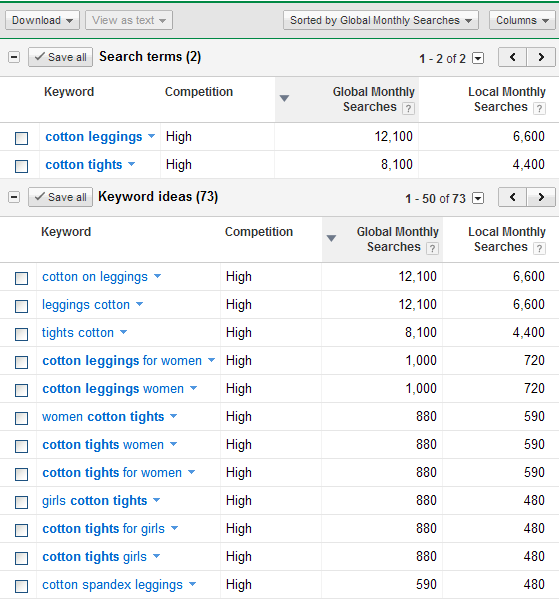Climbing the SEO Mountain with a Simple, Content-Focused Approach
I’ve been closely following the world of SEO for almost a decade now and certainly a lot has changed over the years. Recent Google algorithm updates (Panda and Penguin) have the SEO community scrambling to make technical adjustments, rework their linking strategies, kill spammy microsites, yada, yada, yada…
To be frank, nothing has changed for me in the last decade because my SEO strategy is simple…
- Figure out how people are searching for your stuff
- Create the best content related to that stuff.
This approach has served me and my clients well throughout the years and it’s been really cool to see the sales growth attached to these efforts.
My SEO Routine
Enough high-level fluff…Let me take you into my little SEO trench and demonstrate just how easy your SEO strategy and optimization efforts can be.
1. Look Ahead – Good search engine rankings don’t happen overnight, so it’s good to start this process by looking at your marketing and/or sales objectives a few months out. Are there seasonal trends to consider? Do you have new products/services that you’ll be launching? Do you have specific campaigns that you’re planning? These considerations should start to frame your SEO strategy and help you determine the specific topics, product/service categories or keyword themes that you need to start researching.
2. Find the Money Terms/Phrases – Once you’ve nailed down your categories or themes, plug those general terms or phrases into Google’s keyword research tool. In the “Keyword Ideas” section of the report, note the variations of your phrase and the additional words or “qualifiers” that may need to be considered. Note the monthly search volumes and the overall competitiveness of each phrase. Select and export your initial list of phrases and save it for step 3.
3. Benchmarking & Competitive Analysis – I’ve always loved Avinash Kaushik’s metaphor about driving in a car with blacked-out windows. By looking at your car’s dashboard, you can see that you’re going 60 mph, you have plenty of gas, no warning lights, etc. Everything looks good! But then you roll down your window and you see your competitors flying past you at 100 mph.
Establishing your baselines and then evaluating the competitive landscape (content quality, internal and external links, etc.) is crucial so you can see the opportunities in front of you, determine how high you need to climb, or realize that you might need to pick a different hill. To get your current ranking for any particular phrase, you have a variety of simple, free tools (example here) or paid tools like Spyfu at your disposal.
4. Plan & Produce Your Content – At this point, you have a list of keywords. You’ve seen the quality and characteristics of the webpages ahead of you. Time to get planning. Sit down with your team, pick your target keywords and determine how you will create and package content that addresses those topics. Think website content, blog posts, ebooks, infographics, videos, podcasts, press releases and social promotion. Factor in seasonality, new product/service launches or promotional campaigns. Fill up your editorial calendar and then WORK YOUR PLAN!
5. Optimize Your Output – Another thing that hasn’t changed a lot in the last few years are the on-page SEO basics. Naturally work in your target phrases into URLs, page titles, meta descriptions, heading tags, alt tags, anchor text and general page content.
6. Evaluate Your Progress – After a month or two, I’m always interested to see how the new content has helped elevate our stature. A good way to do this is via Google Analytics. NOTE: In order to generate the report below, you need to make sure you have connected your site’s Google Webmaster Tools profile to your site’s Google Analytics profile. Once that connection has been made, you should now be able to view your “Queries” report under Traffic Sources > Search Engine Optimization > Queries. Using the “Compare to Past” date parameters within Google Analytics, you can see how your “average ranking position” has changed month over month. In the example below, you can see that we improved our rankings from position 59 to 24 (avg) in one month with one blog post dedicated to the term “editorial calendar template“.
7. Keep At It – We’re not done creating content for that phrase. Our goal is a top-5 ranking. But you can see the impact that even one blog post can have. And we can track the impact of all our content development and optimization effort with that report. Now we just have to keep at it. My goal for every SEO-related activity is to show steady progress. When you know the terms that are important and consistently create great content that addresses those terms, you’ll make a dent…promise.
Every Step Counts
Despite everyone wanting the coveted top position for their primary keyword phrase, that can be a big hill to climb. And depending on your product/service offerings, you may have several hills that you need to climb. Just remember that every piece of good content you create is a step up. You just need to make sure it’s a step up on the hill that is going to help you reach your ultimate peak.
Killer Photo Credit: Rob Ellis




[…] Climbing the SEO Mountain with a Simple, Content-Focused ApproachBy Brody DorlandRecent Google algorithm updates have the SEO community scrambling, but a simple, content-focused approach is all you need to reach your peak.DivvyHQ – The Spreadsheet-Free… […]